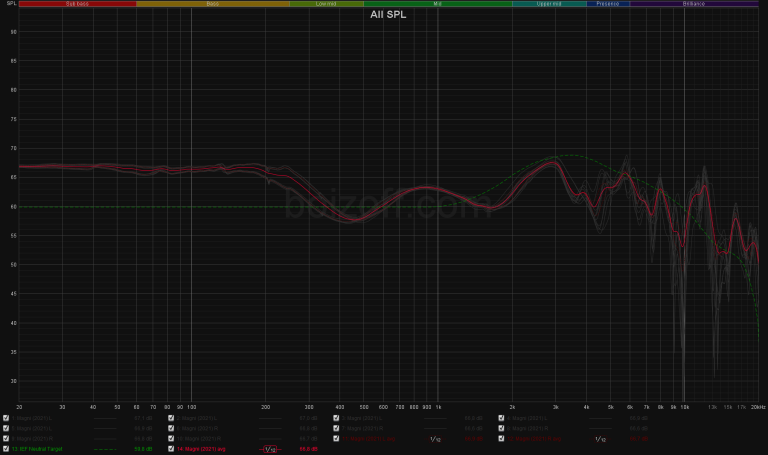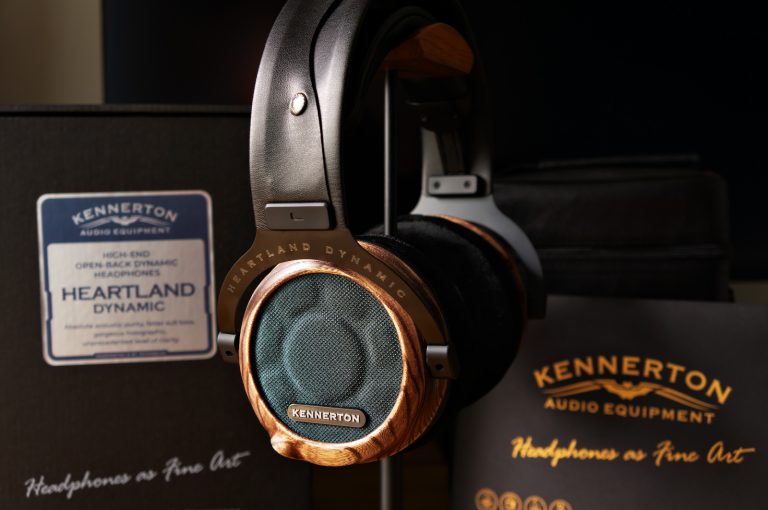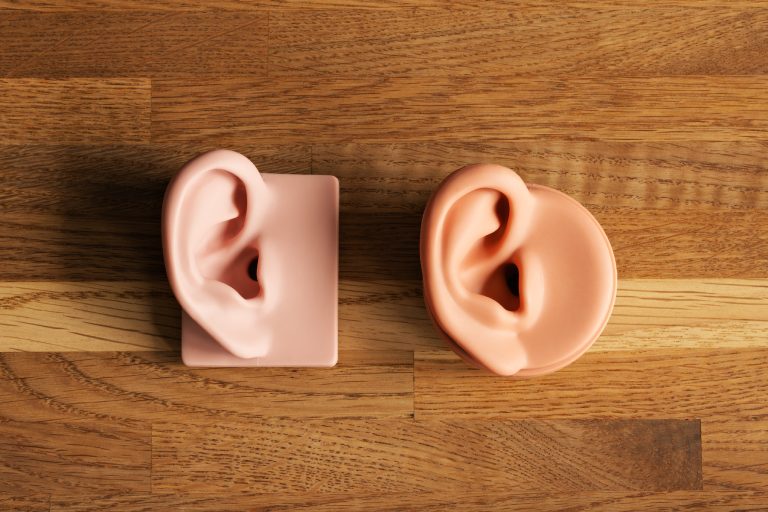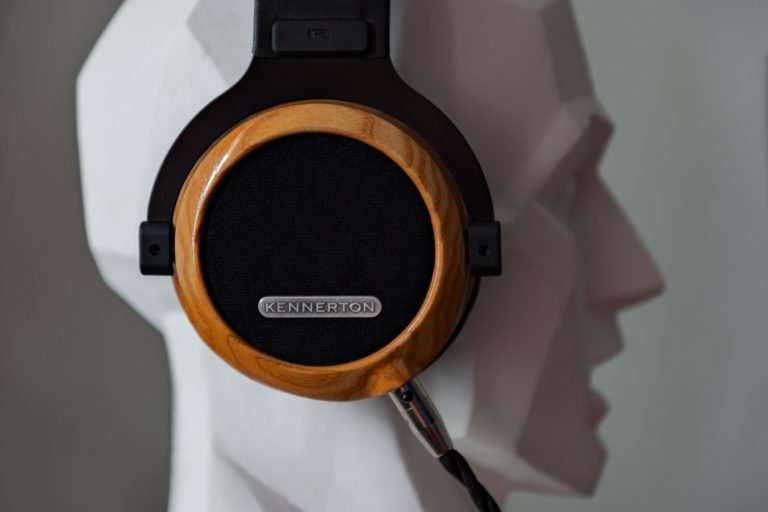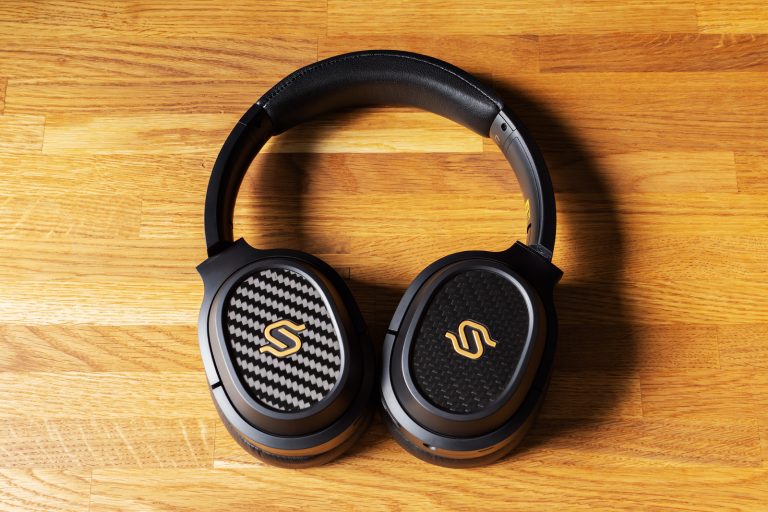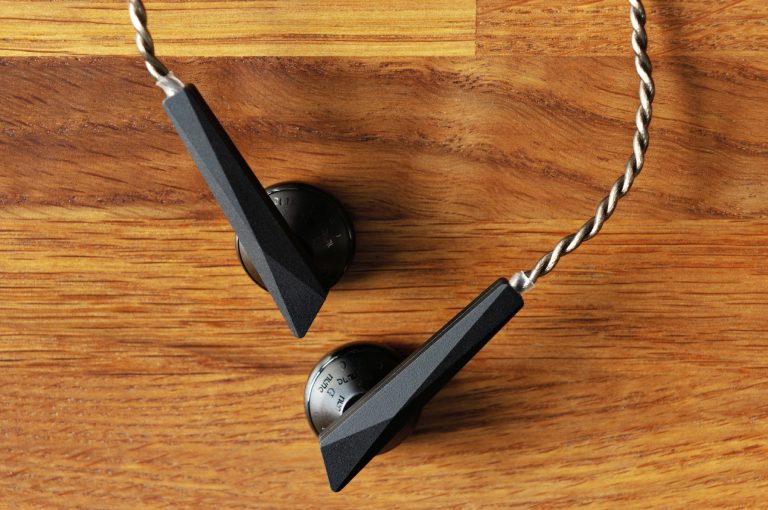Hisenior Mega5-EST Earphones Review. Living classics
The number of earphones around is just way too much. The mere Chinese all together seem to produce a whole new model a day. Therefore, I’m starting to adhere even more strictly to the rule of writing only about good and very good earphones and not writing about bad ones because, you know, life isn’t enough for everything.
And I’ll break this rule right away: today I’m gonna talking not about good, not about very good earphones, but about absolutely outstanding, exceptional earphones – Hisenior Mega5-EST, hybrid in-ears. They cost me $579 of net value + some $49 of tax, or, in total, $628.
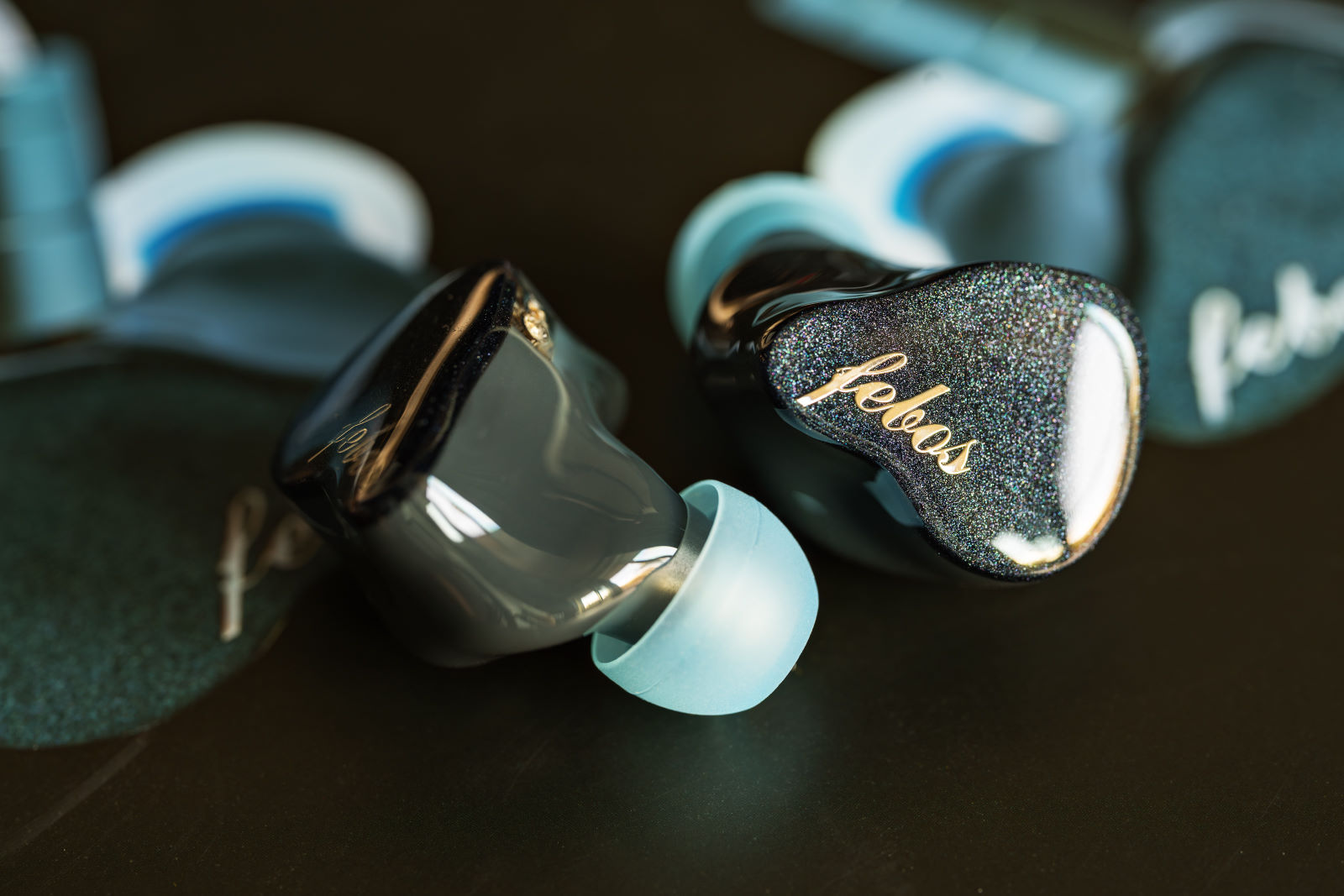
Hisenior and the ‘febos’ word in a nutshell
HISENIOR AUDIO company was opened in 2016 in Chengdu, led by Gareth Chan, and was initially specialized in in-ear monitors for musicians and audio engineers. The company’s first earphones were released under the name ‘Febos’ — Febos FE3U, Febos T2 – and Hisenior’s Twitter account is called ‘febosIEM’, while their YouTube channel is Febos IEM. ‘febos’ stands for ‘feel the beauty of sound’. This abbreviation seems to be present on all earphones of the company. However, there is no ‘febos’ in their name on the official Mega5 page. I assume that this is the original brand, popular among musicians and audio engineers, which they decided not to abandon.
What’s included
The earphones come in a decent large box.
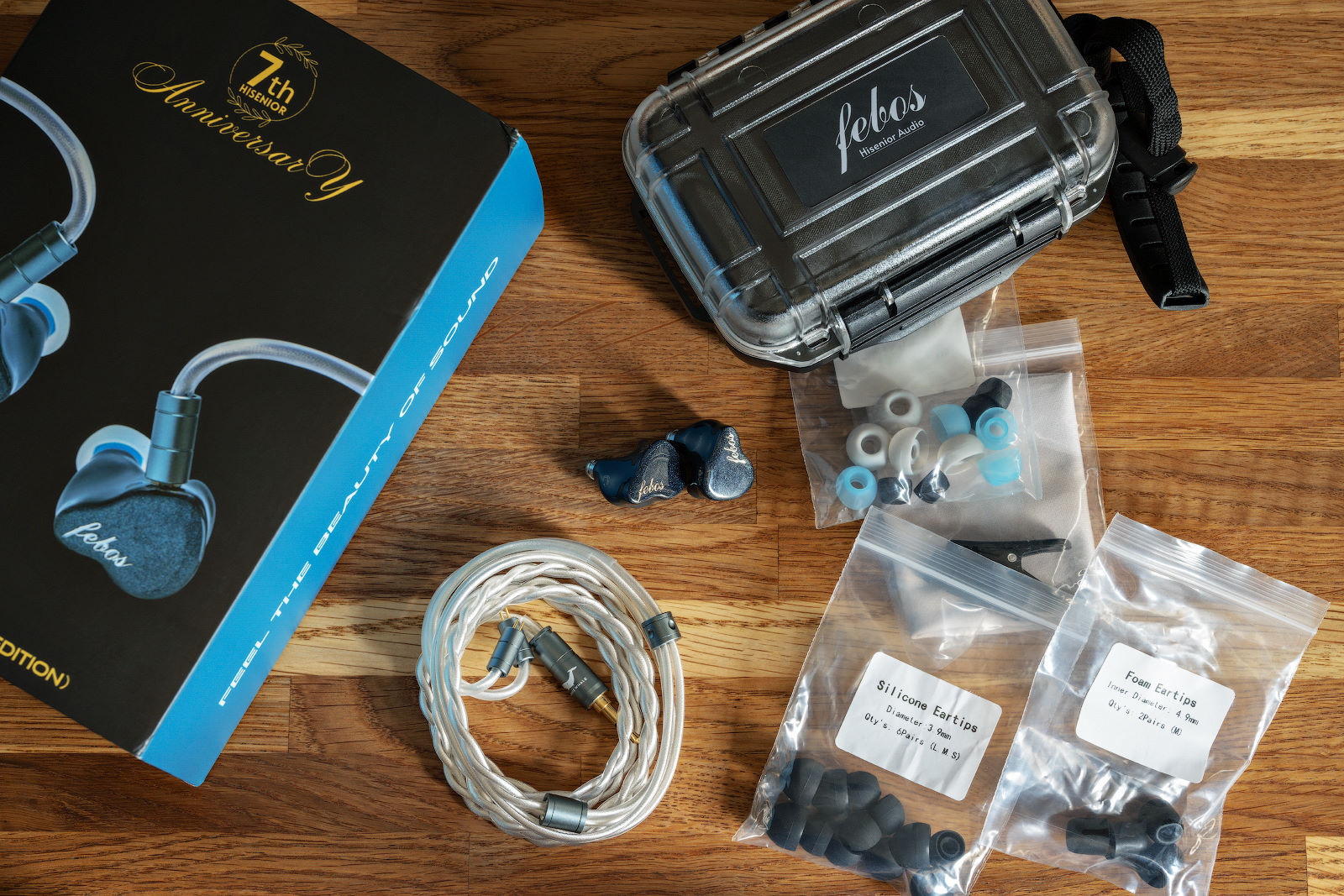
What you get:
- the earphones;
- a 1.2 m long WhiteWhale cable. It’s also sold separately for $96;
- a hefty secure case;
- 12 pairs of silicone and 2 pairs of foam eartips;
- a tricky ‘crocodile’ for attaching the cable to clothes.
It’s a great set, and I’ve never seen cases like this one at all.
The case looks like a product of the famous Pelican company. It’s totally dust-, moisture-, and shock-proof.

Inside, there is a fabric pocket with a zipper on the lid, and the bottom compartment is lined with thick foam and divided into three parts for the cable and each earphone taken separately.
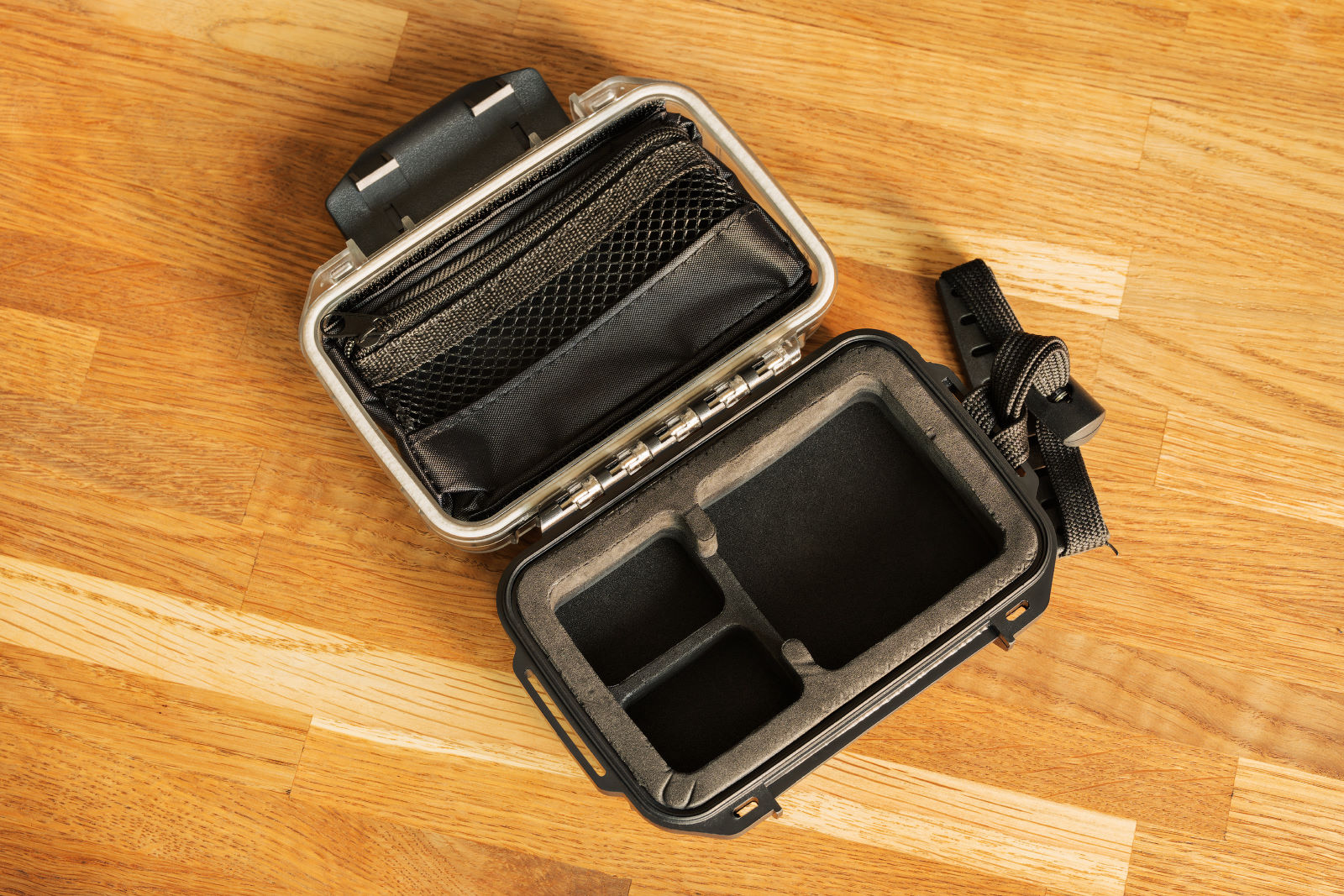
Is there any need in such a case for everyday wear or even for storage? No, absolutely not. But I’m glad that even if a Mega5 box is used as a soccer ball during delivery, nothing will happen to the earphones themselves for sure.
Technological features, build quality
The set of drivers in Mega5 is as follows:
- 1 dynamic driver with a biocellulose diaphragm for low frequencies;
- 2 armature drivers for medium frequencies;
- 2 EST drivers for upper frequencies. EST stands for an Electrostatic Super Tweeter manufactured by Sonion. It appears from the picture on the Hisenior website that the EST65DA01 model is used. They play from 7 kHz and above, as much as up to 80 kHz.
The earphone housings are entirely made of resin and varnished.
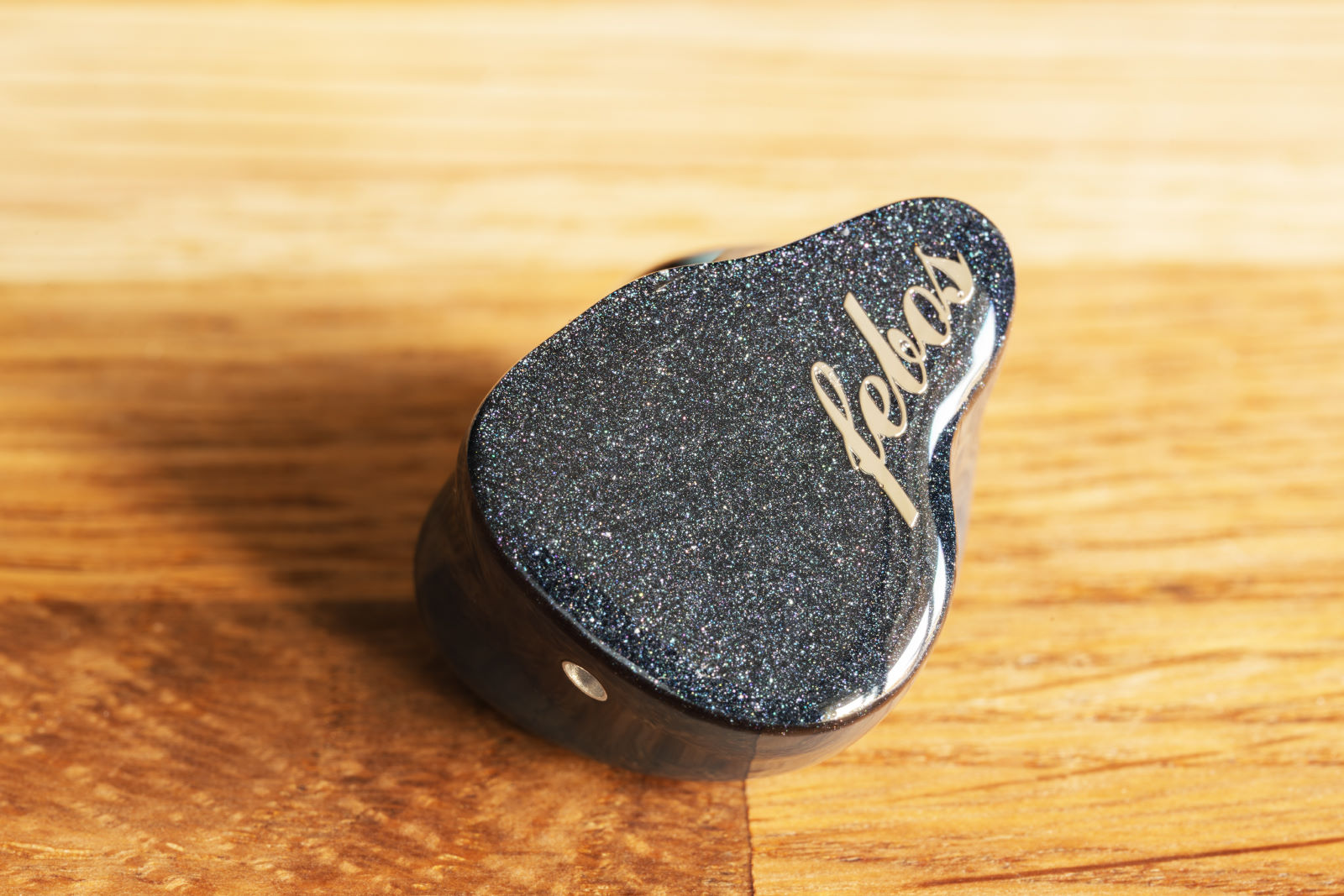
2-pin connectors are used. There is a compensation hole on the back of the enclosure.
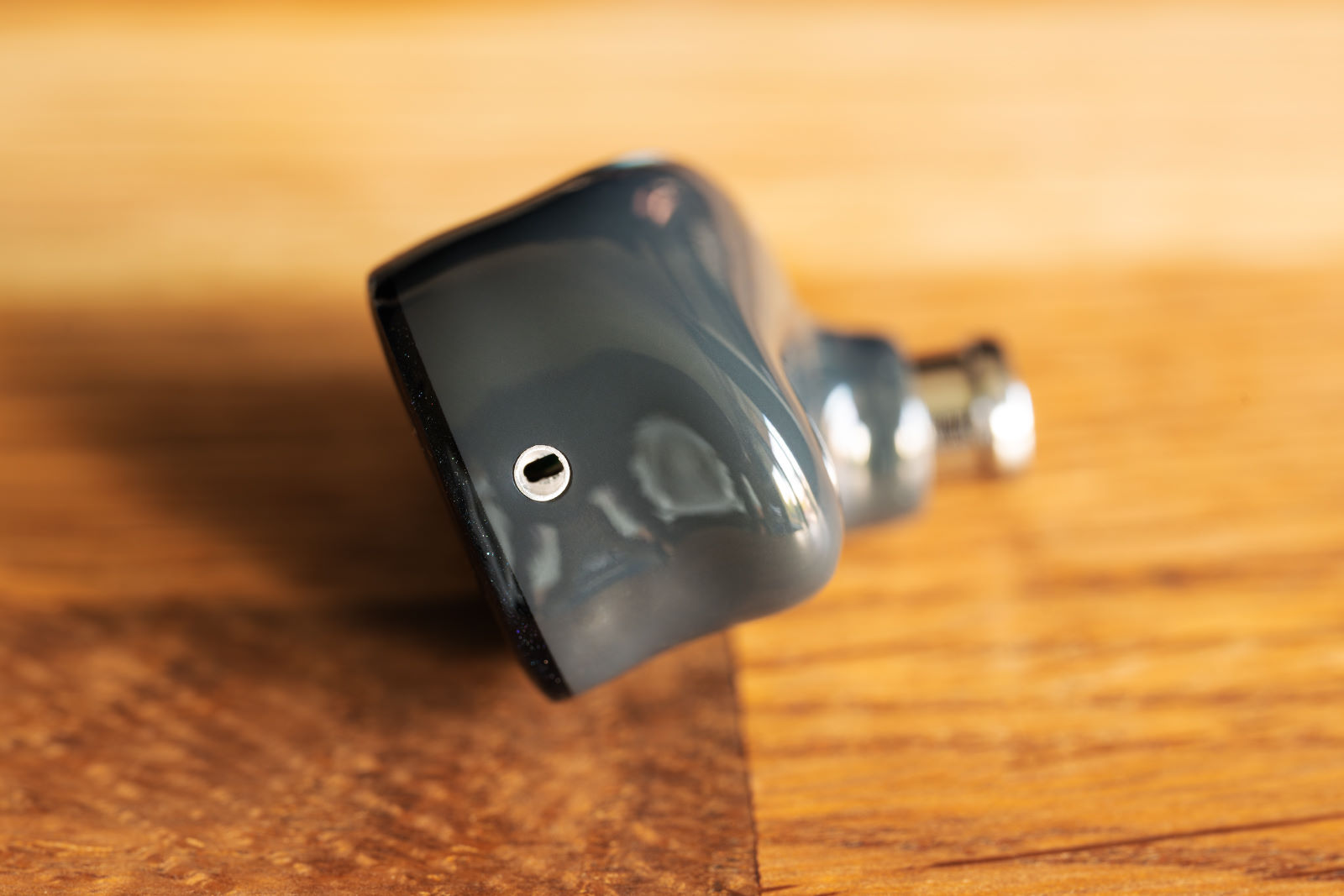
The earphones are made predictably neatly, but not without flaws. For example, on closer inspection, the sound duct grid is glued unevenly. I’ll tell about the rest of the flaws below.

Well, and the cable:
- litzendraht, 290 individual cores woven into two 24 AWG cables;
- silvering with UP-OCC (Ultra-Pure Ohno Continuous Casting) technology, you can find the details here;
- the connectors at both ends are clearly gold-plated.
The cable is called WhiteWhale and is sold separately on the manufacturer’s website for $96. There is a picture of a white whale on the connector in line with its name:
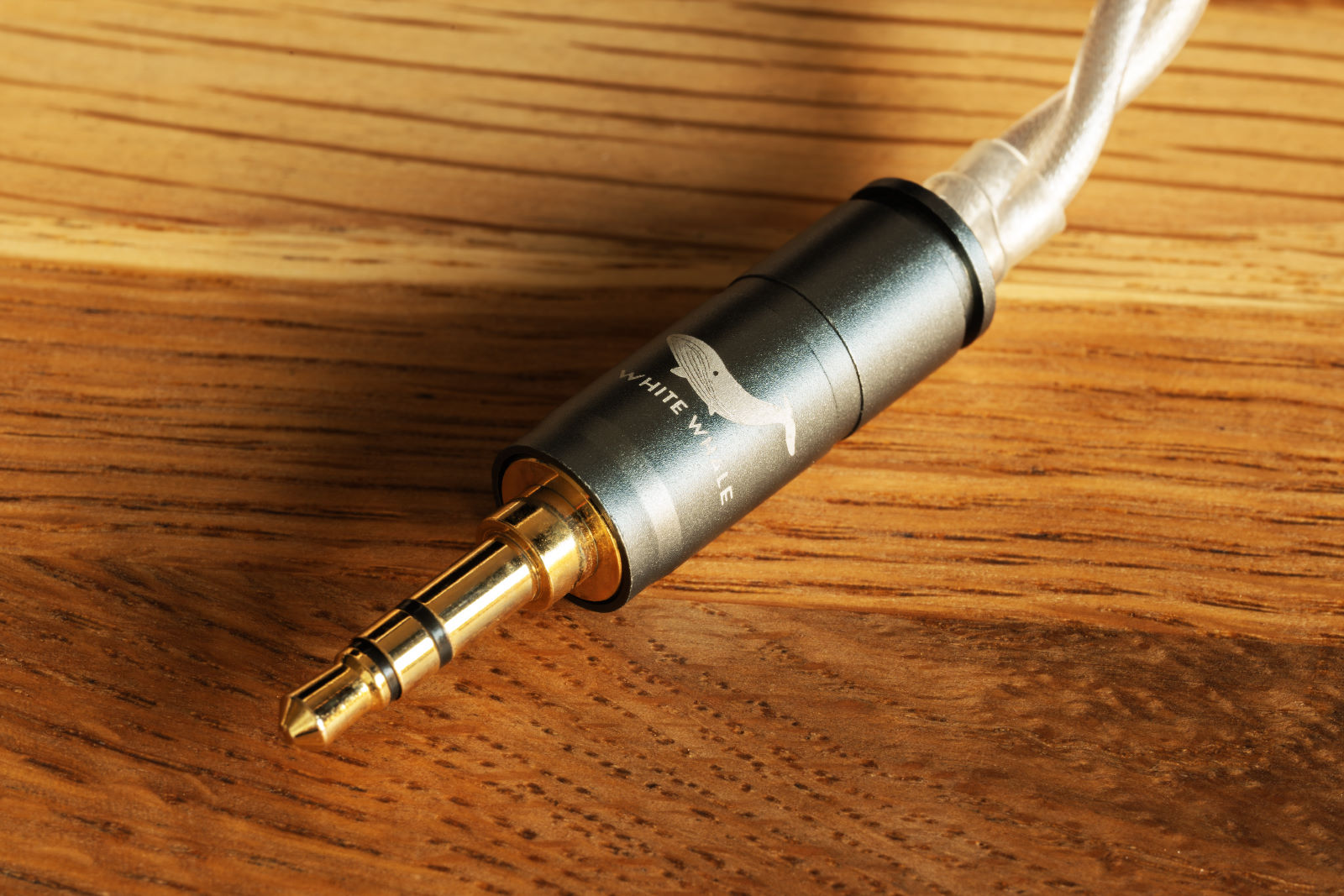
There are no clear left/right markings on the connectors on the earphone side — only a small red dot on one side:
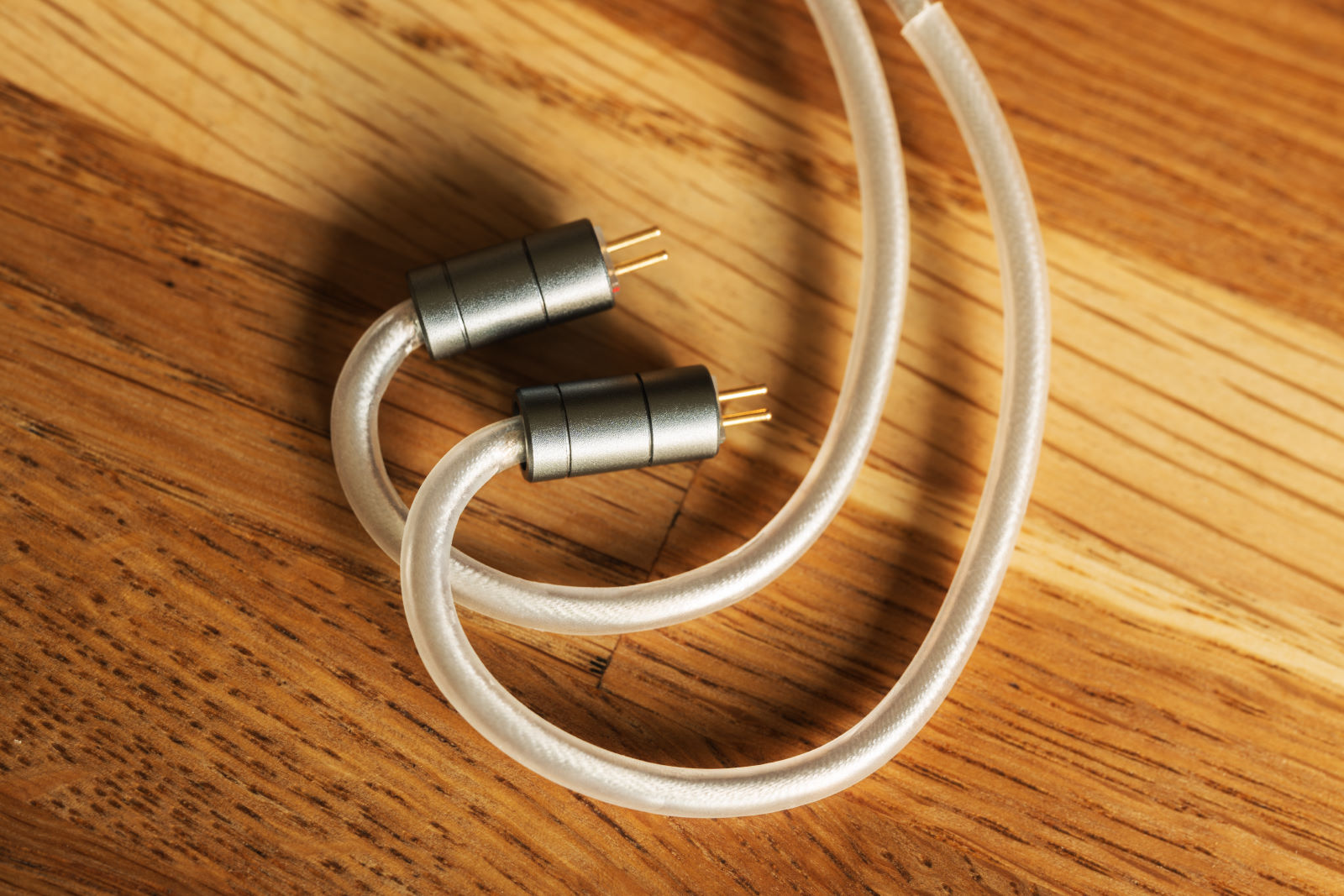
Overall, it’s a nice, convenient, soft, and stylish cable.
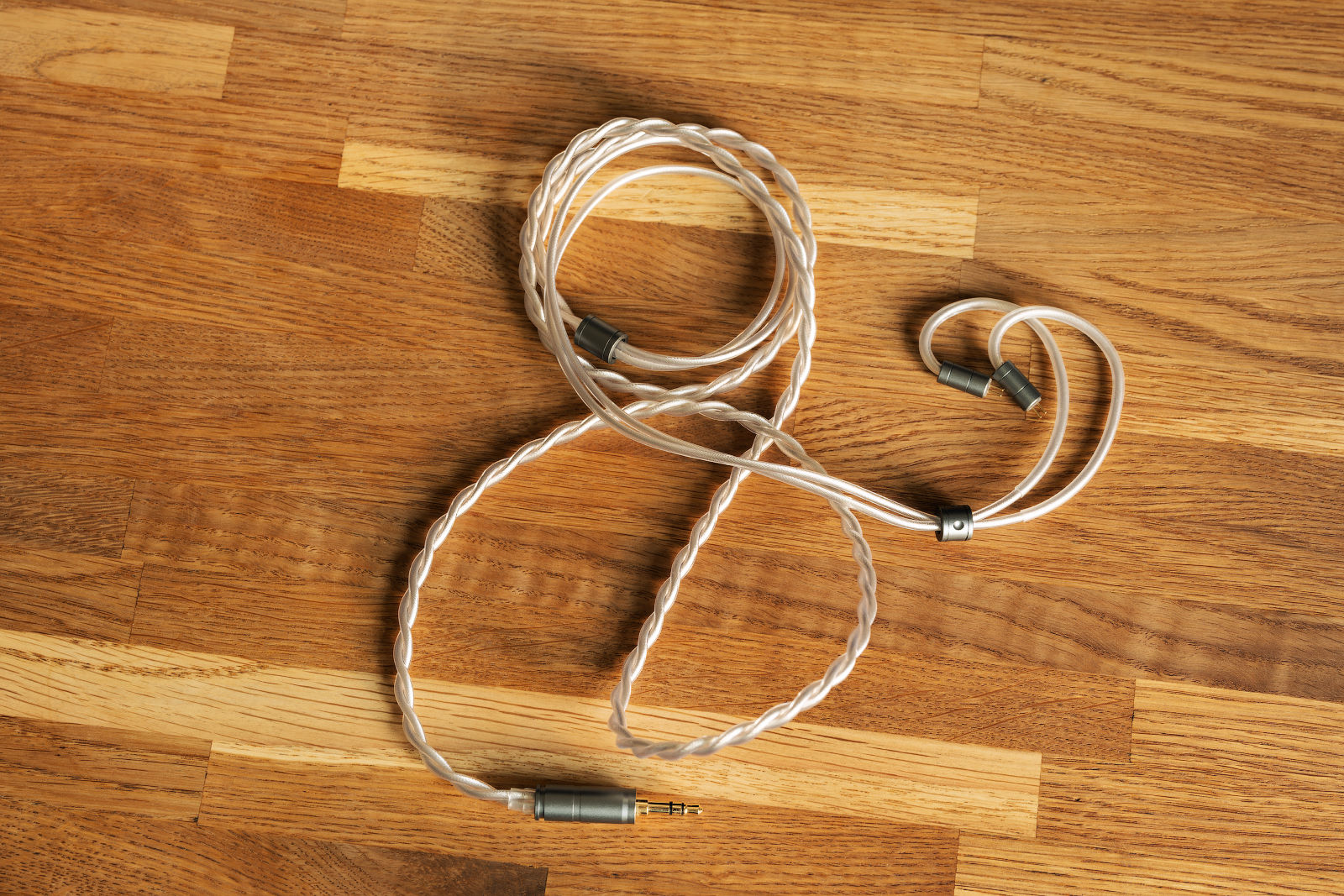
Ergonomics
There are very few earphones which cause me at least some kind of concern with their fit; in fact, I can only complain about XM5. Mega5 became the second model, for which I had to sort through almost all the eartips from my own collection in order to find something suitable, after all. The main problem for me was a thick and long sound duct, which, in the event of Mega5, should sit quite deep in the auditory canal.

However, given that, most of the enclosure is made as if a cast of my ear has been made, so it fits in to the fullest comfort.
The next feature is 2–pin connectors on the earphones themselves. They are made in a way that any cable almost immediately comes out of it by about 1 mm. This is how it looks like after 5 minutes of usage:
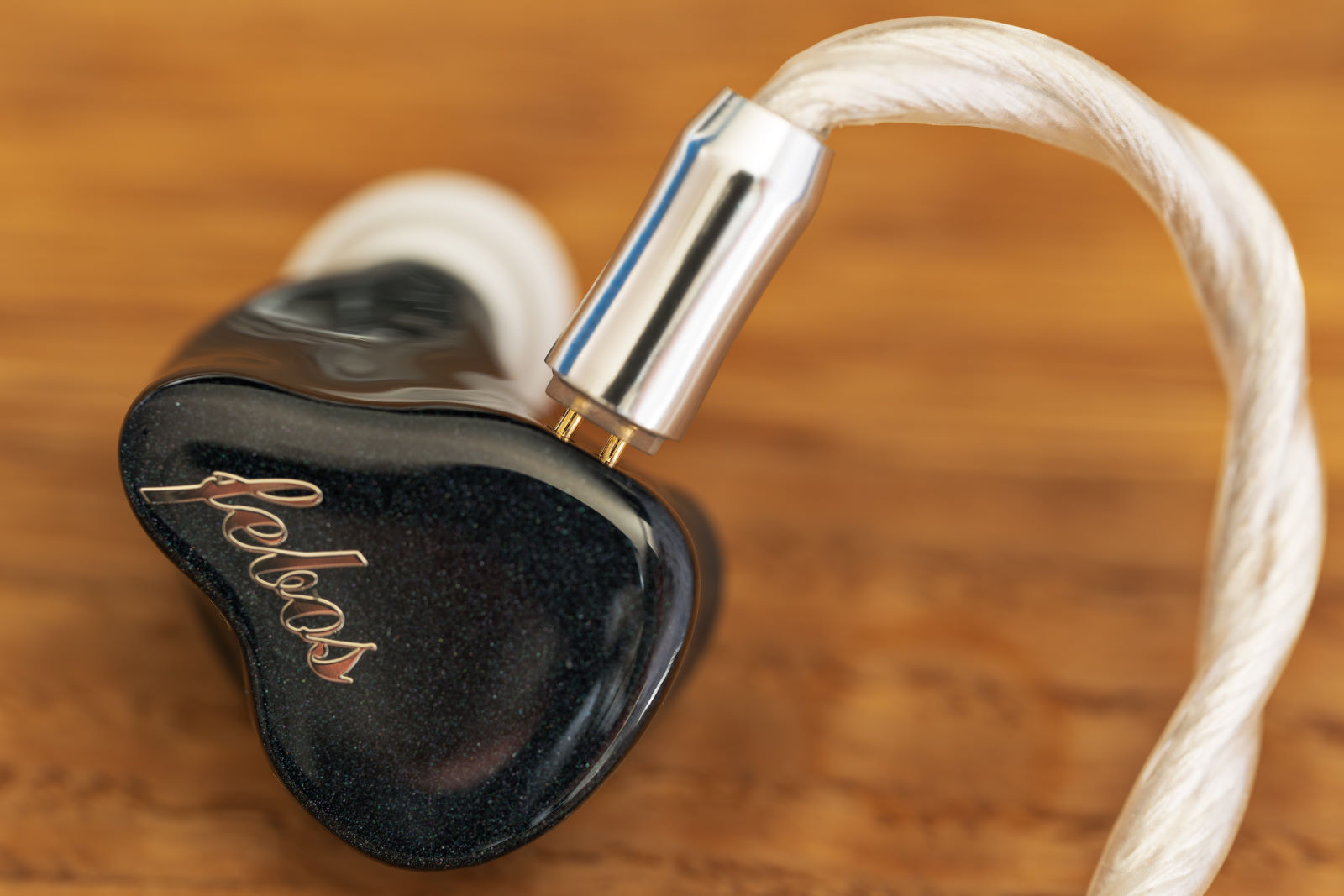
I tried the regular WhiteWhale, my usual QoA RUM, Kinera Ace 2.0, NiceHCK JIALAI JLDT2, and JLY2 – they all do this. They all come out of the connectors by 1 mm. This is not critical. The cables do not completely fall out of the earphones. But still, it’s displeasing to realize that the cable is kind of always ‘not completely plugged in’.
For good measure, the mounting of the 2-pin connector doesn’t have a conventional slot, which theoretically reduces its reliability. And the section of the enclosure, on which there are two pin holes, is not flat.

Everything is working fine for me so far, but there is an increased risk of connector deformation.
Quick specifications overview
- Design: in-ear closed-back.
- Drivers: 1 dynamic + 1 armature + 2 EST.
- Impedance: 25 Ohms.
- Sensitivity: 105 dB.
- Connectors: classic 2-pin, 0.78 mm.
- Weight: 4 g (each earphone).
- Sound duct dimensions:
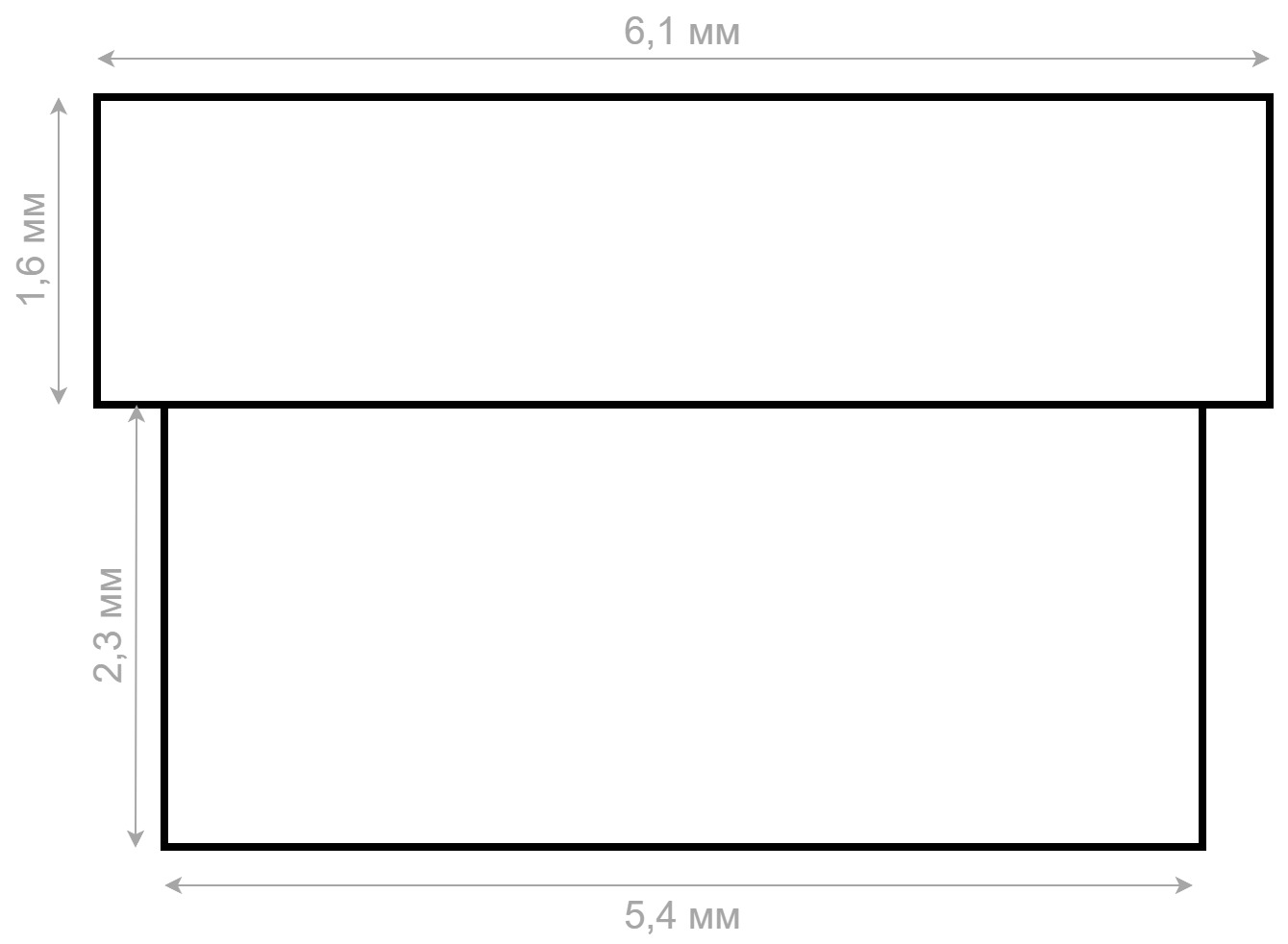
Subjective sound impression
Mega5 turns listening to any track into an adventure: it’s impossible to guess what will ’emerge’ in what track and what new sound will become heard. Mega5 are by no means analytical earphones; on the contrary, they are configured in an extremely non-aggressive and gentle manner. On some tracks, you can hear ringing 3-4 kHz, but this means that this range is significantly emphasized in the very recording. In all other cases, the earphones sort of try their best in order not to hurt the user’s hearing. The prime magic lies in the incredibly, fantastically precisely found balance of all frequencies (and this is not the Harman curve), as well as in a stunningly tuned segment from 10 kHz and above. To my ear, the swipe tone in this area sounds perfectly even in volume, that is, there is no single dip or rise from 10 to 16.7 kHz (the limit of my hearing). Whether it’s the magic of EST drivers or the internal built of the earphone, but the fact remains that I have literally never heard anything like this in my life.
By the way, this magic works not with all eartips, which I’ll tell below.
Nevertheless, Mega5 manage to be both unfatuiguing and informative all in one.
I would describe the overall sound delivery of Mega5 as a bit ‘warm’ sound with an extremely extended ultrahigh frequency range. At the same time, the earphones cannot be called light, not at all. They can’t be called neutral either because the subbass and the bass in them are, like, up the wazoo. But, for sure, the Mega5’s sound can be characterized as very balanced, engaging, and versatile. This, I would say, is their main feature: everything, even the tracks by Cardi B, bless her heart, sounds good with them, not ‘right’, but just like… to the point where you want to listen and listen. Be it Beethoven, be it Dark Tranquillity (they’ve released a great new album, by the way), be it Pink Floyd – any record will sound authentic, monumental, and very, like, interesting. So interesting that in the first week of their use I kind of relistened to my entire music collection that I couldn’t look at without spleen for a year: I’m done with all this music, I thought, I already heard it a thousand times! And there we go!
Lastly, as for the width of the virtual sound stage and the instrument location, Mega5 can set their wits not only to some open over-ear headphones, but, perhaps, even to multi-channel surround-sound systems. These headphones always ‘put’ a listener in the middle of a large stage, inside it, placing instruments around them, clearly conveying the location and remoteness of every sound.
And if you thought about games, you thought it right: I’d easily call Mega5 the best earphones for competitive games and, actually, the best of any and all other headphones of any type. And right now I have Focal Utopia, Dan Clark E3 and some more on my desk. This is so… ‘so different’ that I havn’t lazy to tuck them in my ears every time before a session in PUBG or Arena Breakout Infinite. In single players, you will get a lot of pleasure from the sound too, to put it mildly: I have recently finished Nobody Wants to Die, and I can say with conviction that the sound of rain has never sounded so good in games.
Mega5 disadvantages dialectically stem from their own advantages: the earphones play 8 out of 10 in all parameters, but they don’t come near perfection in any specific segment. As for subbass, it could be more technical and ‘faster’. Say, Binary Audio Chopin can be used as an example. Next comes a loose bass, which is a little too much. The middle range (about 2.5 kHz) is always far from the listener, there is no feeling of real intimacy of the voice, ‘whispering in one’s ear’ in any track. And you can really need it in some music. As a result, something specific may be missing at some points in Mega5 sound delivery when it comes to some specific tracks.
This is all more of nit-picking than of real flaws, but five hundred dollars is five hundred dollars, okay?
However, you will still be highly likely taking these earphones out of your ears only, roughly speaking, to have a bath and a sleep, as all these ‘flaws’ become so minor, literally invisible in contrast to how mesmerizing Mega5 sound in general because they are tuned in such a way that they cannot tire your ear, at all. My record was 12 hours on end without any complaints like “I can’t hear this sawing top anymore” or “I’m fed up with this hammering bass”. And add to this a total nonrivality in recording quality. Even Lacuna Coil played by Mega5 can sound OK, and this is already a success.
By the way, the lack of the ‘middle’ near 2.5 kHz can be somehow compensated by a slight increase in the master volume.
Measurements
The earphones were connected to the RME ADI-2 DAC (IEM output). A measuring rig conforms to the IEC60318-4 standard. The smoothing is indicated on the graphs. For the info about rigs, graphs and headphones measurements, refer to my article.
The frequency response of Hisenior Mega5-EST compared to the Harman curve:
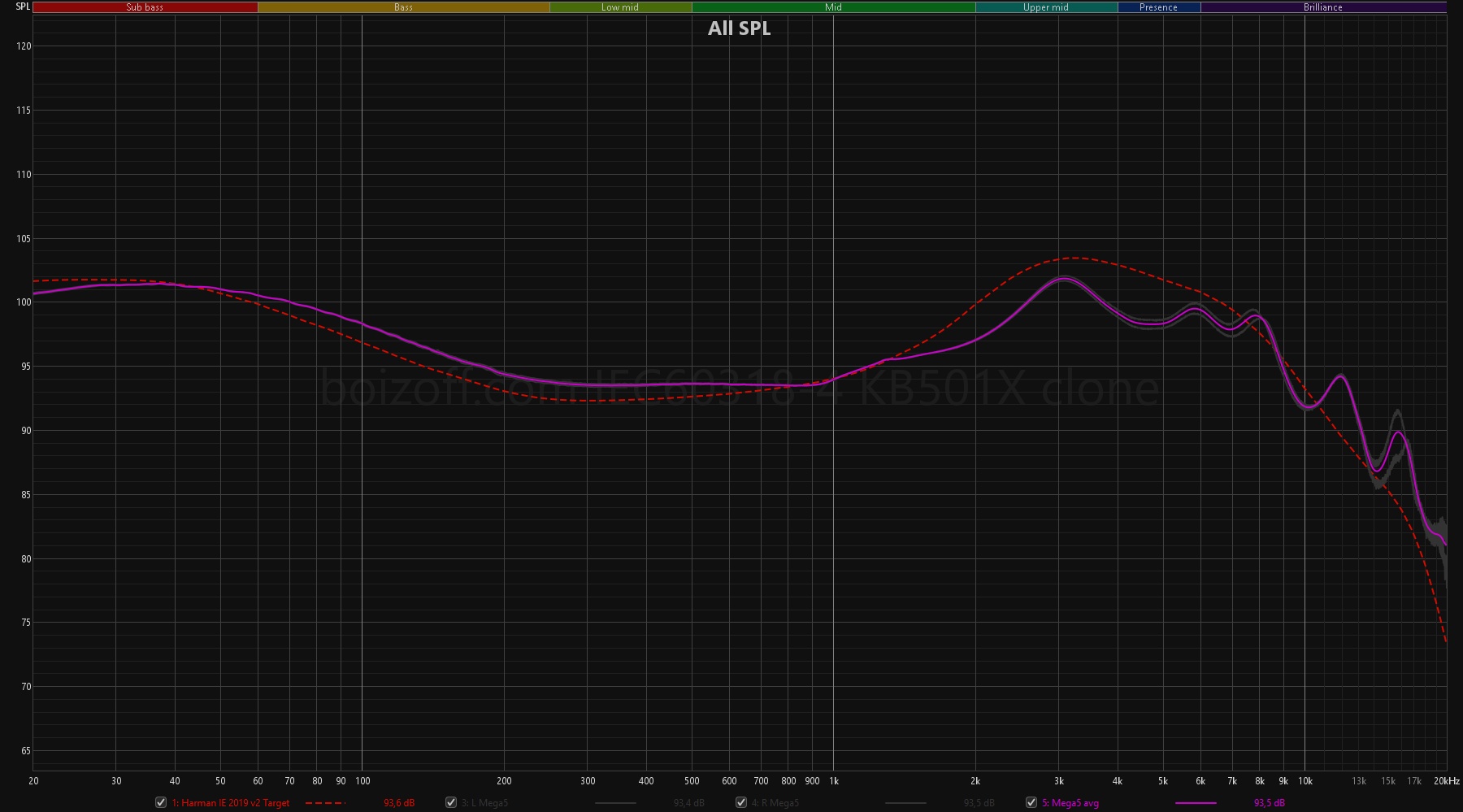
The frequency response of Hisenior Mega5-EST compared to neutral setting (Crinacle 2023 adjusted):
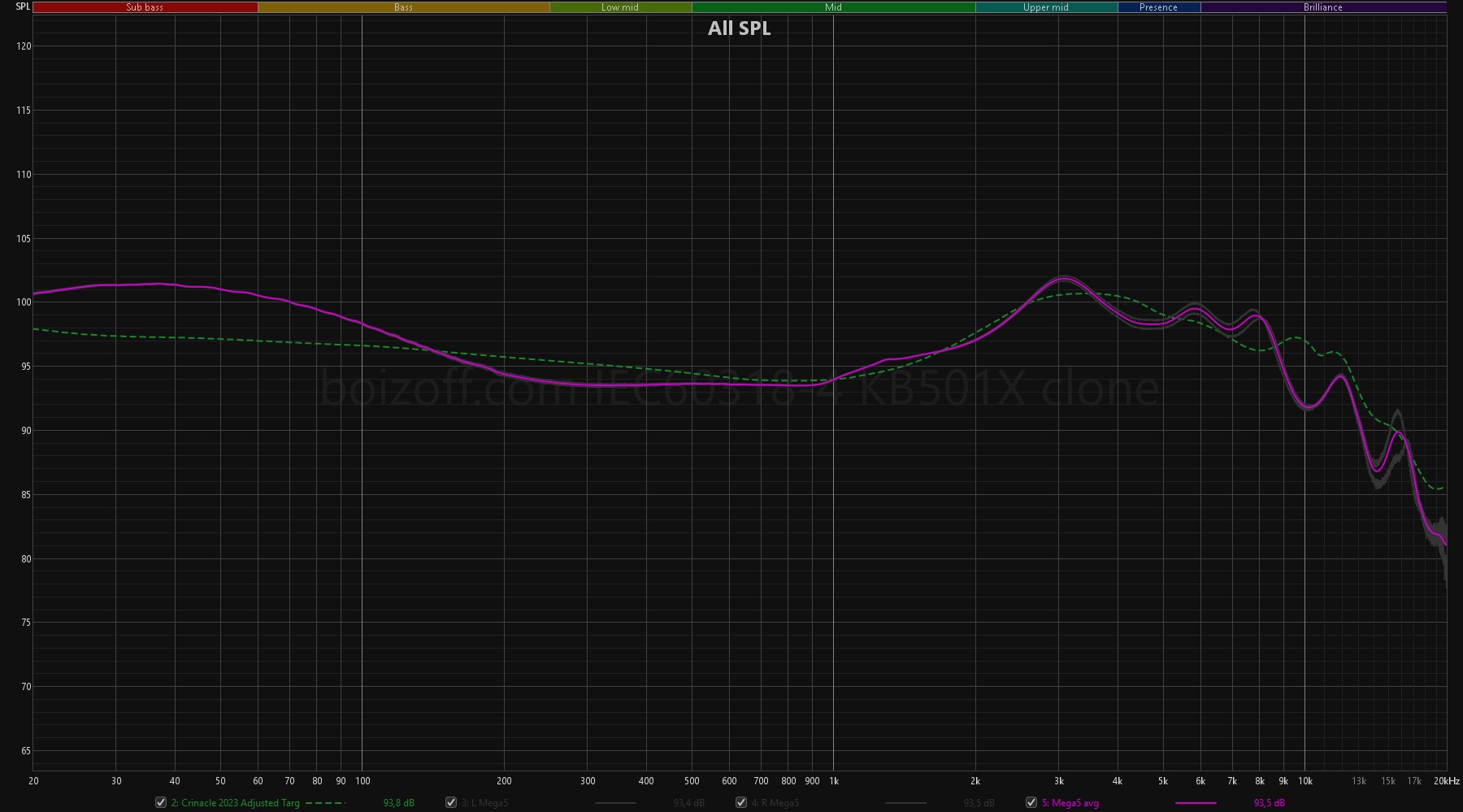
Let me make a point: the frequency response graph was obtained with EPZ eartips, deep fit.
As you can see, Mega5 are tuned much more ‘calmly’ compared with the Harman target response curve, but have an emphasis on subbass if compared to neutral setting.
I’d like to focus on the following:
- the midrange from 1 to 3 kHz is just excellent, but the natural emphasis is shifted upwards, from 2.7 kHz to 3 kHz;
- from 3 kHz onwards, we can see an exemplary ‘line-by-line’ tuning. Let me remind you that the IEC711 standard rig allows making more or less reliable measurements up to a frequency of 10 kHz, so you’ll just have to take my word for it.
Nonlinear distortion at 94 dB of volume. Everything is wonderful:
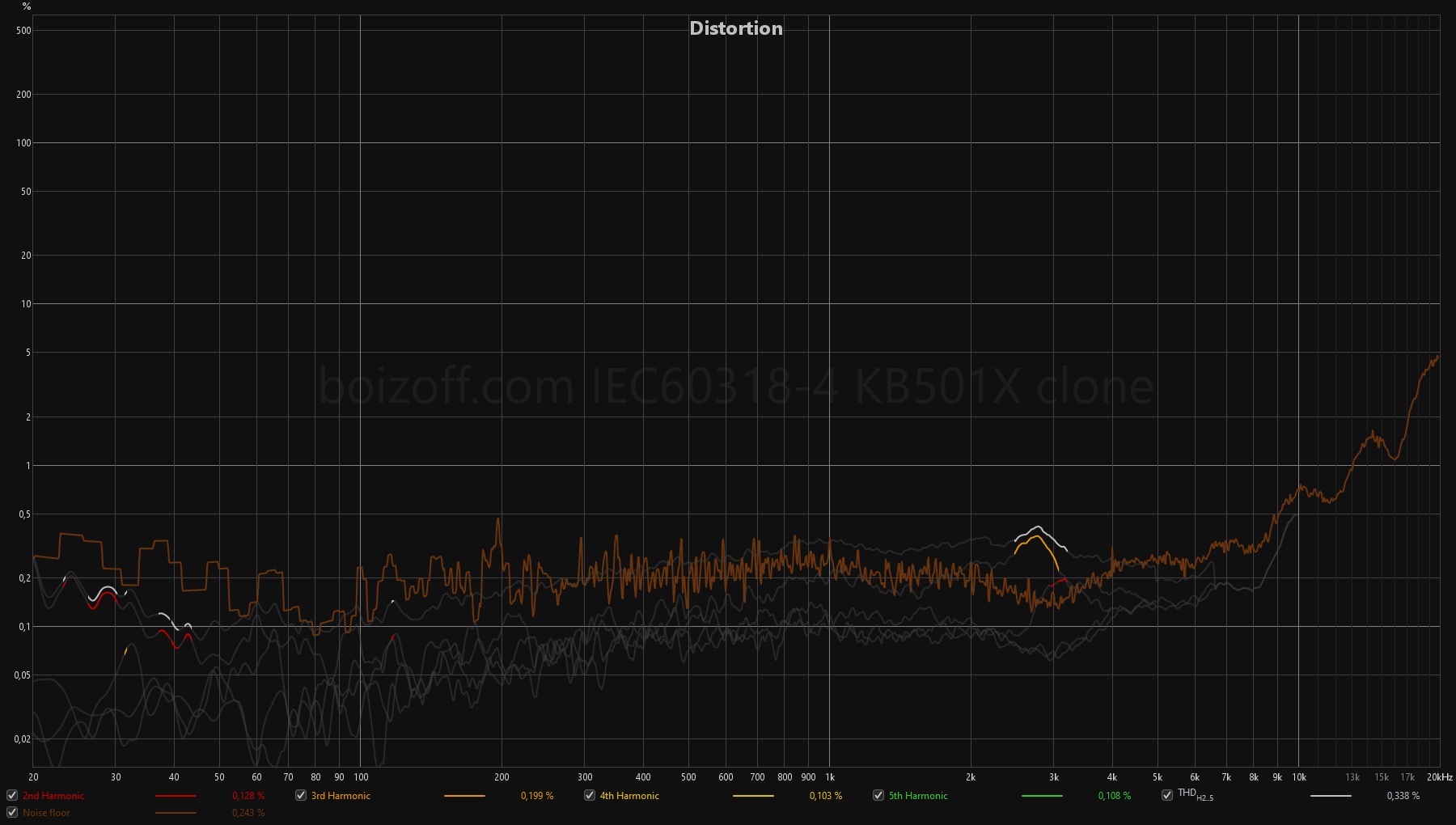
Sound source choice
For my listening tests, I’ve connected the earphones to the following devices.
- PC + RME ADI-2 DAC fs (IEM output) – unbalanced connection;
- Hiby R6 gen 3 (Gain – High, Amplifier Operation – Class A) – balanced connection;
- PC + RME ADI-2 DAC fs (+13 dB at the line output) + Topping A90 (Medium Gain) – balanced connection;
- Moondrop Golden Dawn (Gain – High) – unbalanced/balanced connection.
The earphones do not impose any surreal demands on the amplifier. Hand on heart, Mеga5 sound OK from any of the above sources, and the sound is pretty much the same. Only Topping A90 stands out: it ‘darkens’ the sound, and this spoils the overall picture. But I have no idea why you may need to connect such earphones to A90.
Subjectively, I liked the Mega5 sound the most via RME ADI-2 DAC fs (IEM output). But I couldn’t distinguish it from Moondrop Golden Dawn or Hiby R6 gen 3 in a blind test.
Eartip choice
This will be the first time when I will be talking plain about the clear dependence of the sound of in-ears on eartips. And Mega5 need, really need eartips with two properties:
- not narrowing sound ducts, that is, not narrower than sound ducts;
- short because the fit must be deep.
If these two conditions are met, then my ears and brain begin to perceive Mega5 sound delivery as even more balanced: the subbass is slightly deflated and the midrange is pulled back into place. And the sound stage gets wider, too.
In this context, I found just three options:
- DIVINUS Velvet WB;
- EPZ;
- Zhulinniao Zhu Rythme.
I’ve already written about all three of them here.
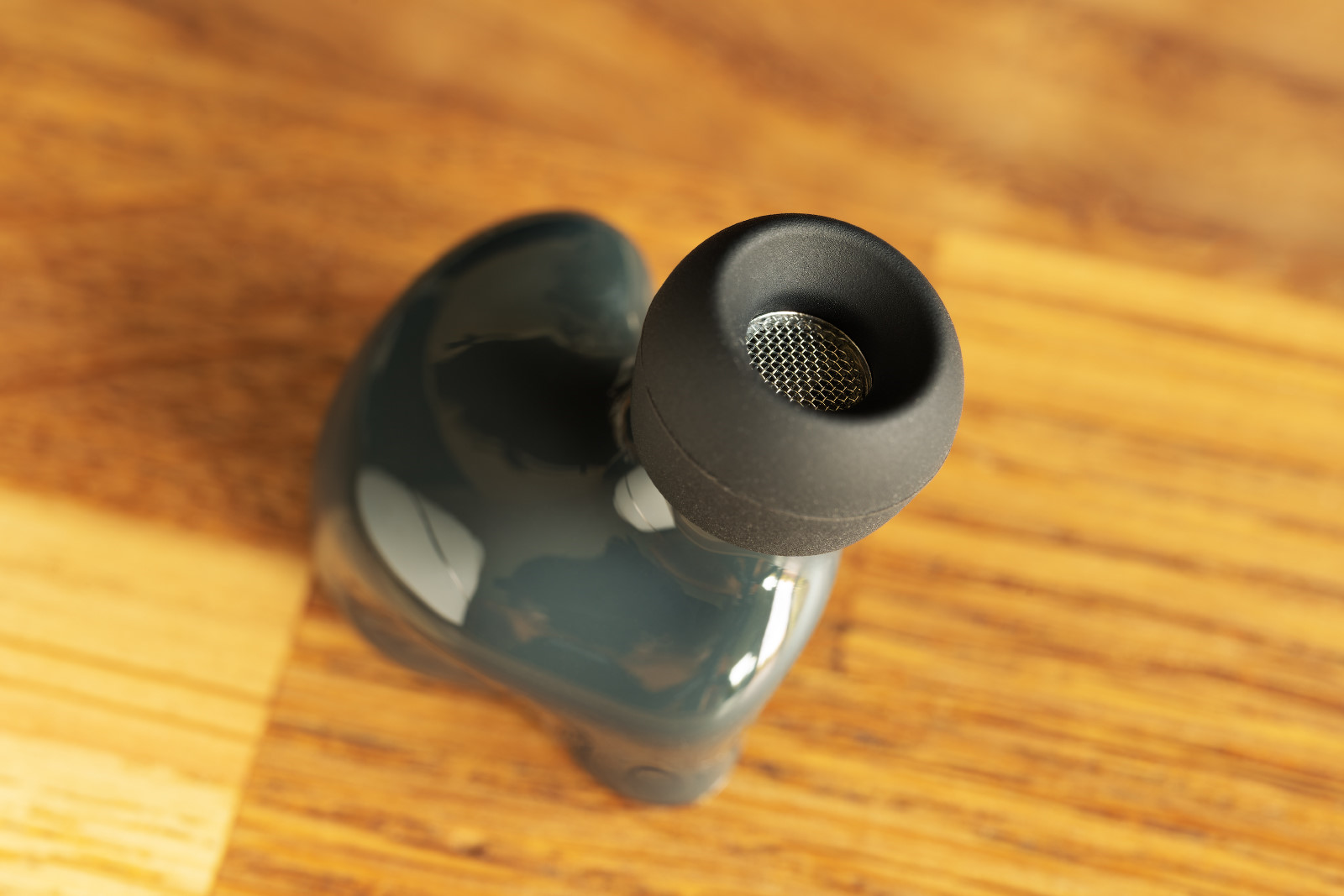
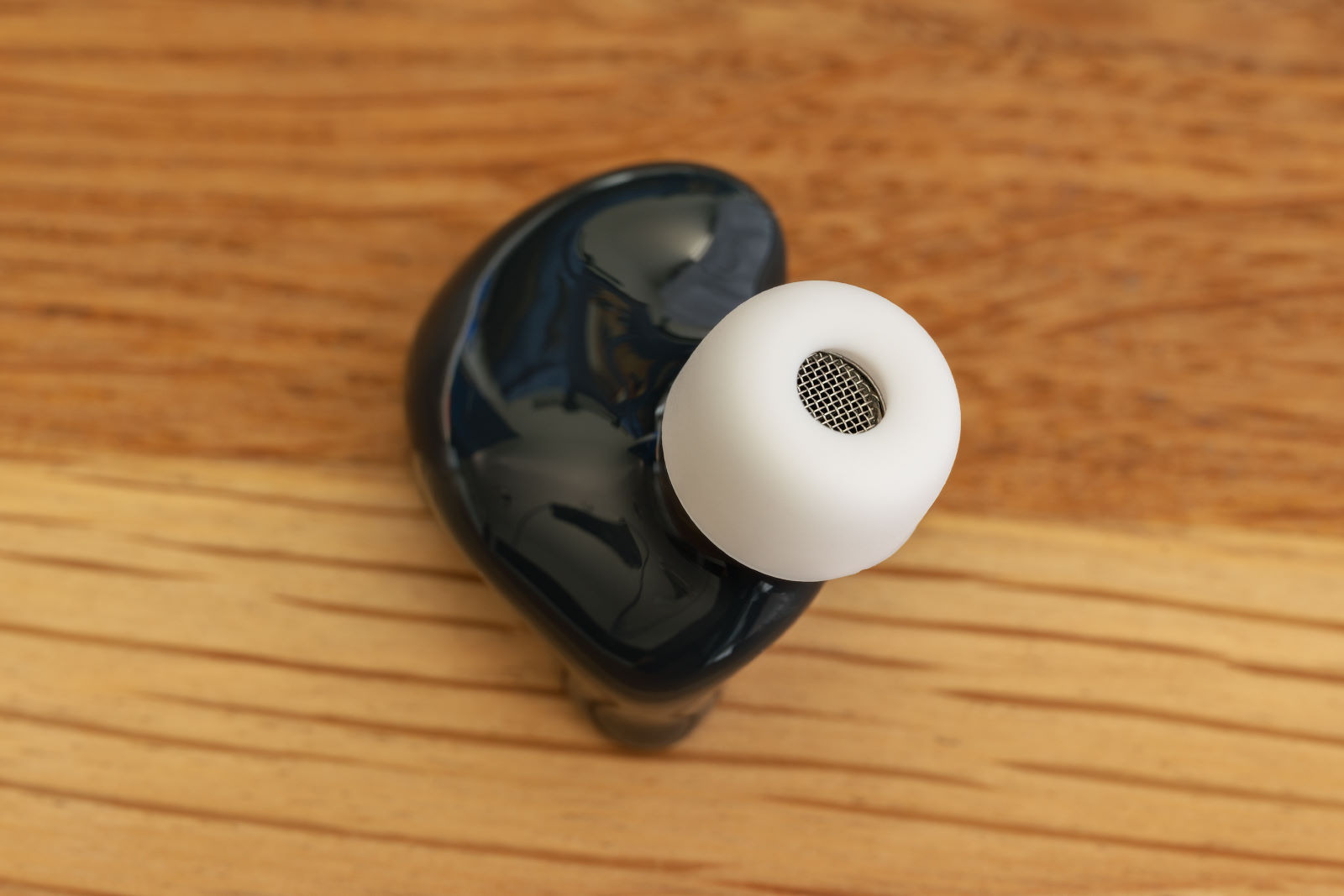
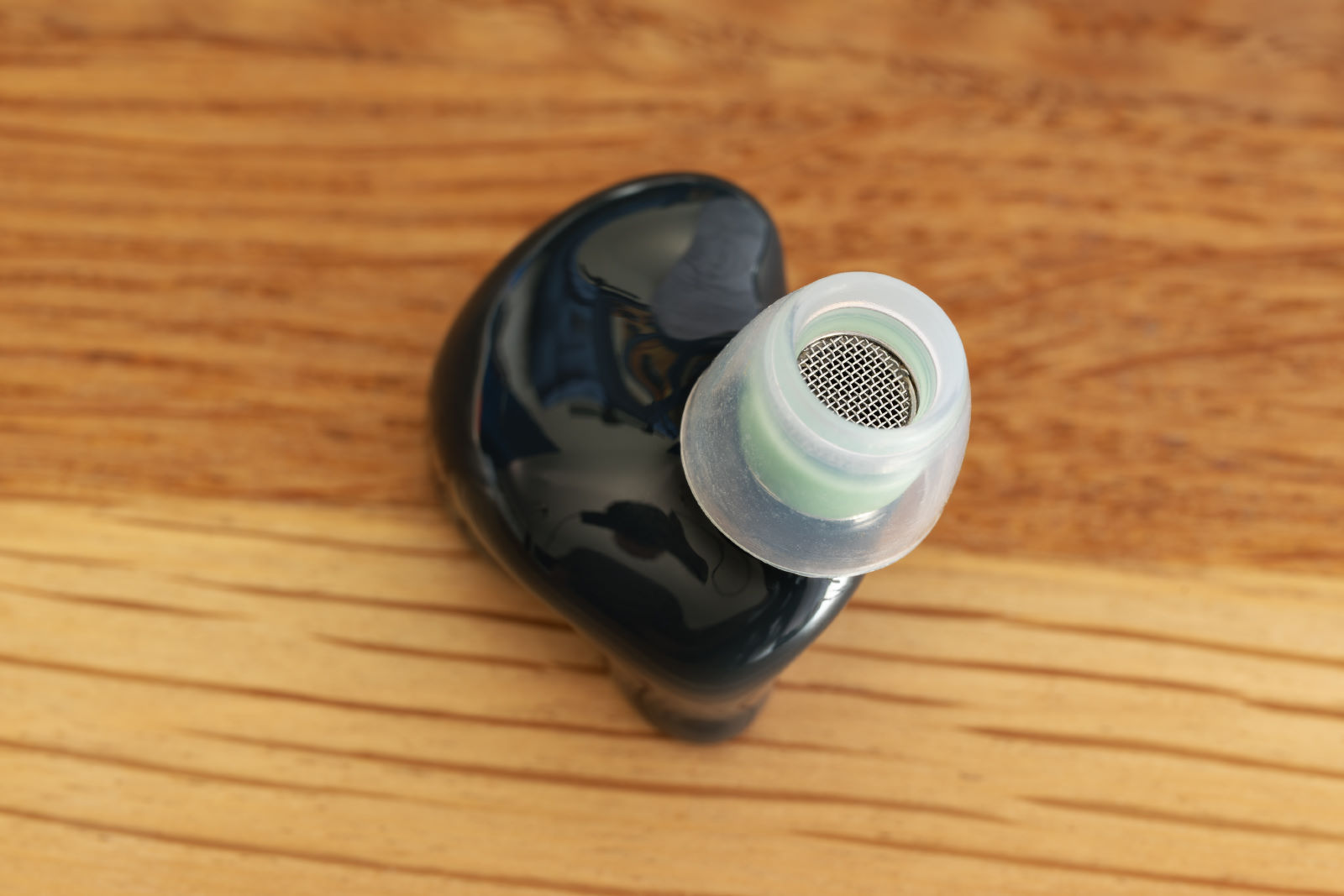
EPZ turned out to be the most ergonomic and interesting in terms of sound for me. Besides, they also have the smallest outer diameter, so the earphones fit into my ears with absolute ease.
But any eartips that have long or, worse, long and thin sound ducts change the Mega5 frequency balance towards focusing on the subbass and bass, which these earphones don’t need at all.
Summary
Mega5 have already become or will definitely become one of the earphones that other models will be compared with for a long time. They’re a pillar of modern audiophile consumer discourse, as significant as Moondrop Variations, ZERO Red, Thieaudio Monarch or 64Audio U12t.
The main thing that you can love Mega5 for is the complete absence of any pronounced features (‘shifts’ in the bad sense of the word) in the sound, ultra–universal sound delivery, unprecedentedly balanced frequency tuning, and good overall technical qualities. Add to this a very wide, deep, and accurately transmitted virtual sound stage, as well as a never-tiring sound.
How could a small company that started with custom monitors for musicians manage that? Whether it’s magic or luck, I don’t know.
And, I note, this situation happens again: what used to be overpriced, costing thousands of dollars just some 5-7 years ago, costs $500 now. It’s relatively much, but for a sound like this, it’s really on the cheap. The thought about what will be sold for $500 in another 5-7 years is scaring me.
We’ll talk more about this trend in a future review of Moondrop Quark 2 DSP.
But what Hisenior definitely needs to work on is the design of jacks for 2-pin connectors. Actually, there is nothing to think about as they just need to do it like everyone else — flat slots and normal clamping force.
To buy or not to buy: yes, out and away. If you don’t like them, their sale won’t be a problem at all.

